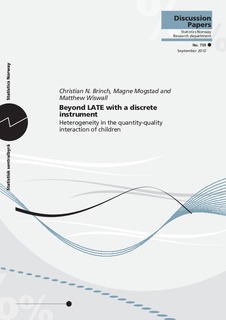| dc.contributor.author | Brinch, Christian N. | |
| dc.contributor.author | Mogstad, Magne | |
| dc.contributor.author | Wiswall, Matthew | |
| dc.coverage.spatial | Norway | nb_NO |
| dc.date.accessioned | 2019-11-13T09:54:29Z | |
| dc.date.available | 2019-11-13T09:54:29Z | |
| dc.date.issued | 2012-09 | |
| dc.identifier.issn | 0809-733X | |
| dc.identifier.uri | http://hdl.handle.net/11250/2628096 | |
| dc.description.abstract | The interpretation of instrumental variables (IV) estimates as local average treatment effects (LATE) of instrument-induced shifts in treatment raises concerns about their external validity and policy relevance. We examine how to move beyond LATE in situations where the instrument is discrete, as it often is in applied research. Discrete instruments do not give sufficient support to identify the full range of marginal treatment effects (MTE) in the usual local instrumental variable approach. We show how an alternative estimation approach allows identification of richer specifications of the MTE when the instrument is discrete. One result is that the alternative approach identifies a linear MTE model even with a single binary instrument. Although restrictive, the linear MTE model nests the standard IV estimator: The model gives the exact same estimate of LATE while at the same time providing a simple test for its external validity and a linear extrapolation. Another result is that the alternative approach allows identification of a general MTE model under the auxiliary assumption of additive separability between observed and unobserved heterogeneity in treatment effects. We apply these identification results to empirically assess the interaction between the quantity and quality of children. Motivated by the seminal quantity-quality model of fertility, a large and growing body of empirical research has used binary instruments to estimate LATEs of family size on child outcomes. We show that the effects of family size are both more varied and more extensive than what the LATEs suggest. Our MTE estimates reveal that the family size effects vary in magnitude and even sign, and that families act as if they possess some knowledge of the idiosyncratic effects in the fertility decision. | nb_NO |
| dc.language.iso | eng | nb_NO |
| dc.publisher | Statistisk sentralbyrå | nb_NO |
| dc.relation.ispartofseries | Discussion papers;703 | |
| dc.subject | JEL classification: C26 | nb_NO |
| dc.subject | JEL classification: J13 | nb_NO |
| dc.title | Beyond LATE with a discrete instrument. Heterogeneity in the quantity-quality interaction of children | nb_NO |
| dc.type | Working paper | nb_NO |
| dc.description.version | publishedVersion | nb_NO |
| dc.subject.nsi | VDP::Matematikk og Naturvitenskap: 400::Matematikk: 410::Statistikk: 412 | nb_NO |
| dc.source.pagenumber | 47 | nb_NO |
